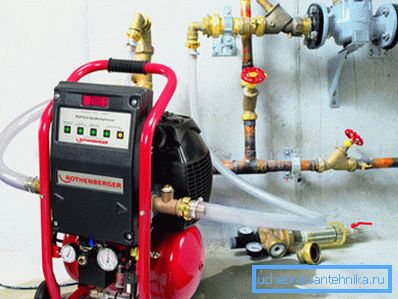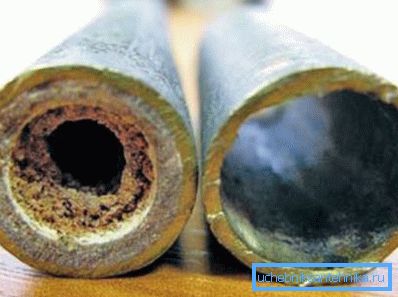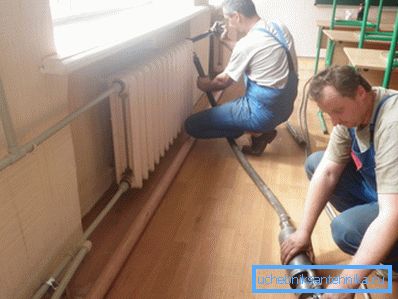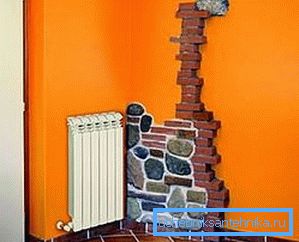What does the hydropneumatic flushing of the heating system
It is impossible to imagine an apartment or a private house intended for year-round living in our country without a heating system. For their long and effective work it is necessary to periodically take preventive measures.
Our task today is to tell about the hydropneumatic flushing of pipelines and radiators. You will learn what it is done for, about the intricacies and effectiveness of the process.

Is it possible to do without washing
The heat transfer medium entering the central heating system is often of poor quality. As a result, scale builds up on the walls of radiators and pipes, which subsequently is a big source of problems.
You can select from them:
- pipeline service life is significantly reduced due to their mechanical wear;
- the system ceases to efficiently transfer heat to the surrounding atmosphere. For example, 1 mm of scale is almost able to reduce heat transfer by a radiator by 15%, since its thermal conductivity is 40 times smaller than a metal surface. Because of it, the latter is damaged, which can lead to the formation of fistulas and damage to the pipes;
- other negative factors should not be overlooked, in particular, a decrease in key heating indicators, which increase the cost of fuel grows with a decrease in the efficiency of the system, and its price today is quite high.

Therefore, it is not worthwhile to neglect the periodic flushing of batteries and pipelines, since its main goal is to maximize the heat output and to save the consumer’s money. You should also understand that parts of the system that are clogged with different deposits often become the cause of emergency situations.
Tip: Ideal - flush radiators and piping once a year.
We recommend that before such work to diagnose the system. Having received detailed indicators, the specialist will see the full picture, which will allow him to know the nature and composition of the sediments.

Due to this, he will be able to pick up the appropriate equipment, and at the end of the flush to perform anti-corrosion treatment. Thus, for some time on the walls will not appear deposits and scum.
When to flush
This will be indicated by signs of a decrease in the efficiency of the heating system.
These include:
- in the autonomous system, unusual and strange sounds will be heard from the boiler from time to time;
- Warming up the system to the optimum temperature for a long time;
- the pipelines are hot and the radiators are cold;
- there was a sharp consumption of energy (for individual heating), which few people will appreciate;
- installation of a new boiler into a previously operated heating system.
Do not try to delay the adoption of measures for a long time, if these signs appear, otherwise emergency situations may arise.
Tip: the main sign of inefficient operation of the heating system is the uneven heating of the coolant pipes leading to the radiators.

Preparation for washing
Consider the process in more detail:
- At the first stage of technology, compressed air is supplied to filled pipes. This increases the speed of the mixture with the creation of high turbulence. The deposits are loosened and begin to be removed from the system.
- Pipe connections with valves and non-return valves must be inserted into the pipeline. If the system is small, water should be fed through the pipes that are already in it. For discharge of the coolant in the return pipeline cut the drain pipe or use special valves. When carrying out the flushing of the system with an elevator, its glass and cone must first be removed.
- The air must be supplied using a compressor to flush the heating system, which is capable of creating a pressure of approximately 6 atm. The check valve is installed on the compressed air pipe so that it restricts the ingress of water into the receiver of the equipment.
Tip: use only high-quality compressor, then you can completely clean the heating system from deposits. It is not necessary to purchase equipment, it can be rented.
When choosing a compressor focus on its technical characteristics. It is desirable that he could automatically adjust the frequency of formation of pulses during the feed of the mixture. It is very good when there is the possibility of adding permitted disinfectants.
Pay attention to the following:
- protection must be provided that will not allow equipment to switch on spontaneously;
- compressor is better to choose a compact and mobile;
- Mandatory condition - indicators showing the level of pressure and flow of flushing water.

Washing process
The instructions below will help to deal with the hydropneumatic method. There are two options:
| Flow through |
|
| Filling system |
|
After washing:
- reduced hydraulic resistance in the system;
- heat transfer will increase;
- fluid circulation will improve.
Remember, for each heating system a separate calculation of hydropneumatic flushing is performed.

Conclusion
It is very bad when batteries cannot provide high heat transfer in an apartment or house due to the fact that they and pipelines are clogged with various deposits. This is especially true for an autonomous heating system. (See also the article Electric heating convectors: features.)
In this case, it will help clean the hydropneumatic method using water and compressed air. The video in the article will help you find additional information on this topic.